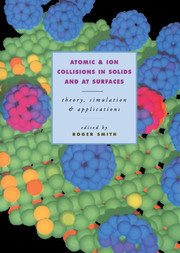7 - Binary collision algorithms
Published online by Cambridge University Press: 13 October 2009
Summary
Introduction
The energetic interaction of a particle beam with a solid cannot be described fully by the path of a single projectile. The path a particle takes and the paths of the subsequent recoils are dependent upon the initial impact point on the surface. Thus, to get a clear description of the effects of particle interaction with a solid, many such paths must be followed. A typical ion beam experiment would entail the interaction of 1011–1020 particles per cm2 of the target.
Trajectory simulations obtain an ensemble – or set – of independent particle solid impact histories. Each history is followed from a different starting point on the solid to simulate the arrival of many particles at random points on the surface.
Conceptually the molecular dynamics (MD) simulation method (see Chapter 8) is the simplest and most complete simulation method to model the behaviour of a solid undergoing energetic particle bombardment; in particular, for calculating the displacement of particles in the solid during a single particle impact. In principle, the development of the ensuing collision cascade is followed chronologically in time as the energy of the ions propagates through the target system. The complexity comes from the solution of the many-body equations of motion which must be performed at successive time steps.
- Type
- Chapter
- Information
- Atomic and Ion Collisions in Solids and at SurfacesTheory, Simulation and Applications, pp. 203 - 233Publisher: Cambridge University PressPrint publication year: 1997

